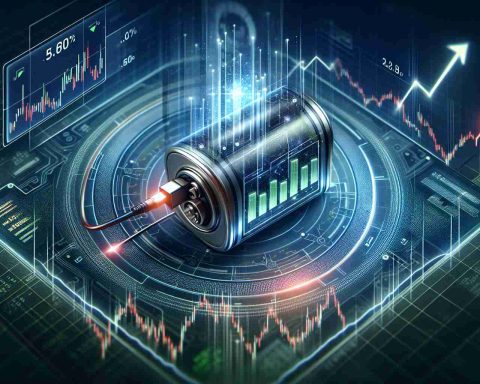In a surprising twist, Toyota is set to revolutionize the electric vehicle (EV) market with a groundbreaking innovation: the solid-state battery. Long lauded for their efficiency in hybrid technology, Toyota has been relatively conservative in the pure EV space—until now. The company recently unveiled plans to incorporate these cutting-edge batteries, promising to enhance the performance, safety, and range of electric vehicles.
The new solid-state battery technology offers a significant leap forward. Unlike traditional lithium-ion batteries, these batteries utilize a solid electrolyte, which drastically reduces the risk of overheating and increases energy density. As a result, Toyota anticipates that their EVs could achieve a range of over 600 miles on a single charge. This breakthrough directly addresses one of the major consumer concerns regarding electric cars: range anxiety.
Moreover, the implementation of solid-state batteries is expected to reduce charging times significantly, potentially allowing a full recharge in just ten minutes. This reduction could redefine the convenience of owning an electric car, making it a more viable option for long-distance travel.
Toyota plans to introduce their first EV featuring this technology by 2026, aiming to leverage their expertise in manufacturing and sustainability. With this bold move, the automaker is not just playing catch-up; it may soon set a new standard in the industry. As the EV market evolves, all eyes will be on Toyota to see if this new technology truly heralds the future of transportation.
Toyota’s Solid-State Battery: A Catalyst for Environmental and Economic Change
Toyota’s announcement of the impending introduction of solid-state battery technology in electric vehicles marks a pivotal moment in the quest for sustainable transportation. This development is not just a leap for the automaker but has far-reaching implications for the environment, humanity, and the global economy.
Environmental Impact:
Solid-state batteries represent a greener alternative to the traditional lithium-ion variants. One major environmental benefit is the drastic reduction in the risk of battery-related fires, which have occasionally plagued lithium-ion systems. This safety enhancement reduces the potential for harmful emissions and pollutants that result from such incidents. Furthermore, with a greater energy density, fewer battery cells are required to achieve the same range, potentially reducing the environmental footprint of battery production and disposal.
The fact that these batteries could enable an electric vehicle to travel over 600 miles on a single charge means less frequent charging, leading to a decrease in the overall energy demand of the EV ecosystem. This can indirectly lower electricity consumption generated from non-renewable sources, contributing to a reduction in greenhouse gas emissions.
Impact on Humanity and the Economy:
Reducing “range anxiety” and cutting down charging times to mere minutes could fundamentally change how society perceives electric vehicles. The convenience and assurance of a long-range, quick-charging EV may boost global adoption rates far beyond current projections. This widespread adoption would translate to decreased reliance on fossil fuels, reducing air pollution in urban areas and improving public health outcomes.
Economically, the introduction of solid-state batteries could initiate a wave of competitiveness and innovation in the EV market. Other automakers will likely invest in similar or alternative technologies to keep pace, driving advancements across the industry. Such competition could lead to lower costs, making EVs more accessible to a broader segment of the population, further accelerating the transition to electric transportation.
Toyota’s manufacturing prowess, combined with this technological edge, might also lead to significant job creation, not only in battery production but across associated sectors, such as charging infrastructure development and electric vehicle maintenance.
Connecting to Humanity’s Future:
The ramifications of this technological shift extend well into the future. By addressing key barriers to EV adoption—range concerns and charging times—Toyota’s solid-state battery could play a crucial role in steering the planet toward a sustainable and carbon-neutral future. The potential reduction in CO2 emissions from widespread EV adoption aligns with global efforts to combat climate change.
Furthermore, as technologies like solid-state batteries advance, they may become applicable beyond individual transport, including in sectors such as aerospace, energy storage, and grid stabilization, enhancing global resilience and energy security.
In summary, Toyota’s innovation in solid-state battery technology not only sets the company on a promising new trajectory but also catalyzes progress towards a more sustainable and economically vibrant future, underscoring the critical intersection between technological advancement and ecological responsibility.
Toyota’s Solid-State Battery: The Game-Changer for the EV Future
Toyota’s announcement of their pioneering solid-state battery technology has taken the electric vehicle (EV) world by storm. This significant innovation is poised to reshape the landscape of electric cars, introducing new possibilities for consumers and competitors alike. Here, we delve deeper into what this breakthrough means for the market and potential users.
Innovations and Features
The solid-state battery is a remarkable advancement. By replacing the liquid electrolyte found in conventional lithium-ion batteries with a solid electrolyte, Toyota is ensuring higher safety standards, reducing the risk of overheating, and substantially increasing energy density. This technology not only promises an impressive range of over 600 miles on a single charge but also alludes to a future where electric vehicles can easily rival, if not surpass, the convenience of traditional gasoline cars.
Pros and Cons
Pros:
– Enhanced Safety: Reduced risk of fire and overheating.
– Extended Range: More than 600 miles on a single charge.
– Quick Charging: Potentially full recharge in just ten minutes facilitates faster and more convenient road trips.
Cons:
– Development Time: With the first vehicles expected in 2026, consumers will have to wait before experiencing these benefits.
– Cost Considerations: Initial production costs might be high, potentially reflected in the vehicle pricing.
Market Predictions and Trends
Industry experts predict that Toyota’s entry with solid-state technology will spur other manufacturers to accelerate their research and development in similar domains. This can lead to a competitive leap, fostering innovations that would improve battery efficiency, reduce costs, and prioritize sustainability. Furthermore, the ability to address range anxiety and charging time concerns makes EVs a more attractive option for diverse consumer demographics, likely increasing global adoption rates.
Sustainability and Environmental Impact
Toyota’s focus on sustainability extends beyond just vehicle performance. Solid-state batteries utilize fewer toxic materials, offering a smaller environmental footprint compared to their lithium-ion counterparts. This breakthrough aligns with Toyota’s broader commitment to reducing the carbon footprint and promoting clean energy solutions.
Security Aspects
Solid-state batteries not only enhance performance but also security aspects. The solid electrolyte inherently increases stability, reducing risks associated with thermal runaways—a common concern in existing battery technologies. By ensuring that battery systems remain stable under various conditions, Toyota further guarantees the safety of their vehicles.
Comparison with Current Technologies
Compared to existing lithium-ion batteries, solid-state batteries are a superior choice in many facets. Conventional cells carry safety risks and offer less energy density, often necessitating heavier and bulkier battery packs. Toyota’s new technology promises lighter, more efficient systems that could redefine vehicle design aesthetics and engineering moving forward.
Cost and Pricing Speculations
While Toyota has yet to finalize pricing details for their upcoming EVs equipped with solid-state batteries, experts suggest that initial costs may be steep due to the novelty and complexity of the technology. However, as production scales and efficiencies are realized, prices are expected to become more competitive, making these innovations accessible to a broader consumer base.
Conclusion
Toyota’s solid-state battery is poised to be more than just a technological revolution; it’s a bold statement in the ongoing transition to sustainable transport. As the industry watches Toyota’s every step, it stands as a powerful reminder of the potential within the EV landscape. To explore more about Toyota’s technological advancements, visit their official website at Toyota.













